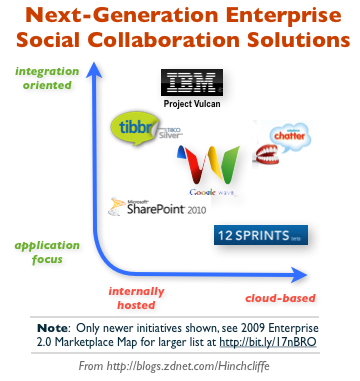SAP's 12Sprints joins the social enterprise bandwagon

A clear business focus helps, but 12Sprints must go up against SharePoint. I spent some time this morning working with SAP's new 12Sprints collaboration service, which was announced earlier this week. Available free in open beta immediately, it's a cloud-based service that's a cross between Basecamp and Google Wave and is ostensibly designed for team collaboration.
Not incidentally, 12Sprints is also clearly a social application and it includes viral invitation, extensive commenting and discussion capabilities, and interesting new twists on measuring community opinion such as real time consensus tracking.

Not that 12Sprints is neither as large and complex as SharePoint nor a grand unified vision like Project Vulcan or Chatter. Instead it has a solid focus on on-the-ground collaborative decision making, group discussion, and project planning. It's clear though that it can grow far beyond these functions with its open architecture and flexible structure and will likely do so as it matures.
12Sprint's activities for social collaboration
The basis of operation for 12Sprints is the activity, which can be one of the following types below. An unlimited number of these can be engaged in at any time and a search function and various timelines are offered to make large amounts of activities manageable and navigable.
- Prioritization Activity. Create shared goals/objectives, rank them, and capture the final outcome
- Project Planning Activity. Define a timeline, project objectives and goals
- Decision Activity. Define a situation, set options, gather consensus, reach a final decision, obtain sign off
- Discussion Activity. Define a topic for discussion, build a threaded discussion, capture the results
- Meeting Activity. Arrange a meeting, record notes, capture decisions and action items, and define next steps
- Research Activity. Define a research topic, collect and share relevant artifacts
- Blank Activity. A freeform slate for collaborative activities.
It's important to note that 12Sprints doesn't try to be the best at everything, a fault that's endemic to large enterprise application suites and which is wisely avoided here. It does however integrate with best-of-breed services where it makes sense, whether they're from SAP or not. This includes WebEx, Evernote, and Scribd, with the first two custom-integrated and the latter as part of their extensions program. With extensions any developer can onboard their functionality to 12Sprints, which offers users an experience not dissimilar to an app store and makes it possible for anyone to enhance the platform.
Who will find 12Sprints compelling? Those who have traditional, non-collaborative desktop and communication tools. E-mail and instant messaging is an obvious competitor for many of the tasks that 12Sprints targets, while Microsoft Project, Web conferencing, and knowledge/document management tools are as well in terms of more directed and less open-ended apps.
Screenshot of 12Sprint's Activity Page
Most applications that users have today in these spaces are showing their age and 12Sprints offers a compelling alternative. Yet it's one that eschews the standard trappings of blogs, wikis, and social networking of many common Enterprise 2.0 tools for clear focus on artifacts that represent common business activities. 12Sprints is also clearly a modern Web application with a highly responsive rich user interface, an up-to-date look, dynamic visual displays, and interactive features that have collaboration baked right into them. This latter item is unlike the often quite non-social enterprise applications of today, where e-mail is still used as the primary means to circulate artifacts for comment and input (with the attendant difficulty of reassembling all the input and revisions).
Related: A round-up of 70+ enterprise social software solutions.
Instead, with 12Sprints everyone works on a common, shared set of artifacts simultaneously. Comment boxes are often the most prominent user interface element and getting anyone, anywhere to join collaboratively into an activity is very easy to do.
In my experience, centralized approaches like 12Sprints pay for themselves by dramatically cutting down the work of incorporating collaborative feedback by doing it right as the feedback is made. 12Sprints hits the mark here, though its important to remember that ROI comes in many forms with social software. In the beta version of the service I used today, collaborative simultaneity is not nearly as seamless as say Google Wave's is. But it's good enough for most team-based tasks and I think it's quite a bit easier to use than Wave.
Focus helps, but 12Sprints must go up against SharePoint
Interestingly, it's very sense of focus and lack of enterprise-style Swiss Army Knife features won't make 12Sprints a replacement for most of the tools it competes against, and for which SharePoint will likely be first on the list. Like so many of these types of collaborative applications, 12Sprints offers a capable experience and useful functionality, but definitely as an additional tool in the toolbox. Unfortunately, it still remains unclear if users will primarily adopt social computing when its added to the platforms they use most today, or if they will seek out new social experiences where and when they prefer (raising the growing shadow IT in the cloud question).
Since it seems like enterprise social computing adoption is most likely going to be a combination of both, there is certainly still room in an increasingly crowded enterprise market for 12Sprints, but it will likely have an uphill battle. If its extensions marketplace grows and SAP puts its very considerable muscle behind it, it may do well. But the relatively low-key announcement here indicates that it's probably a side-bet or a research stepping stone -- though a smart one -- for now.
You can begin using 12Sprints in beta today at http://12sprints.com/.
Are you looking at integrated social computing solutions or individual best-of-breed apps? Please leave your comments in Talkback below.